Creator’s YouTube Page || Official Download
Hey, it’s another Mega Man fangame and this one even actually stars the Blue Bomber himself! I’ve covered one of these nearly every month on Indie Overlook and there are quite a few more out there which I’d like to cover in the future, so for this article on Mega Man: Super Fighting Robot I’ll be experimenting with the format a bit.
This article will serve as a general overview of my thoughts on the game, but there will be a new, short article every day, starting tomorrow, to cover a specific stage along with a video. You can think of these articles as supplemental material; I’ll be adding a new section to the site for them soon and they won’t get in the way of the standard Tuesday and Friday articles. With all that out of the way, let’s get started!
Plot:
It’s the year 20XX and the city is under attack by an army of robots lead by Proto Man! Yep, it’s virtually identical to the plot of Mega Man 5 and there’s not much else to say about it this time around. The few cutscenes which exist tend to be surprisingly wordy and have few images or pieces of animation to them, but they can easily be skipped or fast-forwarded. There’s nothing outright awful about this plot, it’s just unoriginal and the presentation is on the bland side of things.
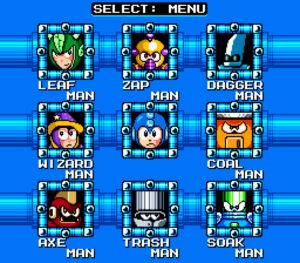
Gameplay:
Mega Man: Super Fighting Robot controls as smoothly as an official entry in the series. There are plenty of bells and whistles here, but nothing which hasn’t been seen before. Mega Man has access to charge shots and a generous slide, which can clear single-tile gaps, and starts with the always-handy Rush Coil. The Rush Marine isn’t in this particular game, but the Rush Jet can be obtained after clearing a certain stage and letters can be collected to gain access to Beat, who flies near Mega Man and shoots lasers. There’s an unfortunate lack of controller support and Quick Swap is present to easily allow for swapping between weapons without opening up the menu, though it inevitably becomes faster to just open the menu anyway once Mega Man’s arsenal starts to get filled in. 1-ups are common in stages, but rare as enemy drops, and the game is extremely stingy with E-tank placement, but Bolts are plentiful and can be used in the shop to buy quite a few items, including 1-ups, E-tanks, M-tanks (which refill both weapon energy and health), a ridiculously cheap Energy Balancer, a slightly more expensive ‘Energy Saver’ (which cuts weapon energy use in half), four passive gear upgrades, and, of course, hair dye for Dr. Light.
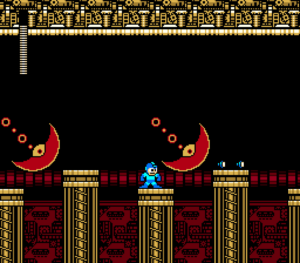
Music:
If there is one thing the Mega Man series has more or less always been known for, it’s the music. As for the music in this fangame, there isn’t a single bad track, but most of it is not particularly memorable either. The star of the show is easily the Stage Select track as it’s an 8-bit rendition of the theme song from the cartoon show, which serves as the namesake for this game, and it’s just as obnoxiously catchy as ever. The music during boss fights, both for the original eight robot masters and in the fortress stages, is also great and carries a fantastic sense of energy. Otherwise, songs usually sound appropriate for their stages, but rarely leave much of an impression.
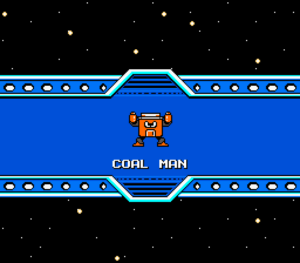
Robot Masters:
Ah, now here’s where this game starts to shine. There’s a great balance here between relatively ‘normal’ Robot Masters like Leaf Man and wonderfully goofy ones, most notably Trash Man. As unmemorable as most of the music is, just about every Robot Master here has something distinctive about them, from Dagger Man’s cool, stylish design to the remarkably silly design of Soak Man; my favorite is probably Coal Man, who seems to literally be a coal furnace with arms and legs. These bosses aren’t pushovers either as most of them have three or four different attacks. Boss patterns are generally predictable, but actually dodging every attack is another matter entirely as not only is each arena shaped to give its boss an edge, but nearly every boss has at least one attack which sticks around for a while, forcing you to deal with two different sources of danger at once. Though bosses do not possess any sort of ‘ultimate attack’, several of them do seem to become slightly more aggressive or change up their patterns slightly as the fight goes on.
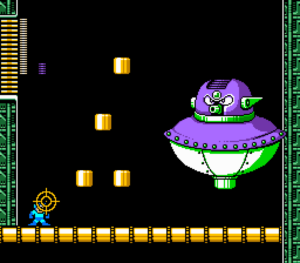
Weapons:
This game has some phenomenal weapons for Mega Man. There are two things in particular which just about every Robot Master weapon in Mega Man: Super Fighting Robot does right. First, each weapon targets a different part of the screen; Magic Missile is weak, but homes in on targets and bounces to new targets if it destroys them, Giant Axe can be shot in three arcs which vary greatly in both horizontal and vertical reach, Soak Rain shoots out three clouds which spread horizontally and rise while rapidly dropping damaging rain onto enemies, and so on. The second important part of a good Mega Man weapon which these abilities get right is in utility. Not only does each weapon have a specific, unique form of attack, but every weapon also has a unique trait. For example, Trash Attack causes explosions which can damage Sniper Joes and other shielded enemies even when they are defending, Leaf Boomerang can grab items, and Zap Barrier makes Mega Man outright invincible for a few seconds. The only weapon which I didn’t use frequently was Flash Dagger, which can be held in place until you release the button, causing it to quickly shoot forward in a straight line, and Mega Man gains a brief window of invincibility if the button is held long enough; the high speed doesn’t really make up for the low damage and Zap Barrier is just all-around better when it comes to granting invincibility frames. Even though Flash Dagger may not be the best weapon around, I found myself constantly using the other seven and the Energy Balancer combined with the Energy Saver ensured that I always got plenty of use out of each of them.
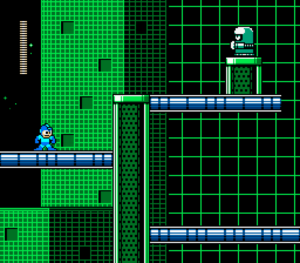
Stage Design:
Every stage here is well-crafted, but not usually in the way you might expect from a Mega Man game. The big selling point for most Mega Man games, fangames included, is the presence of an interesting mechanic in each stage, but that’s not really true for Mega Man: Super Fighting Robot. Nearly every fortress stage makes great use of some sort of gimmick, such as a targeting reticle which chases Mega Man through most of the second fortress stage, and a few of the Robot Master stages also make good use of a defining feature, such as Coal Man’s stage being filled with exploding platforms and floating flames which can be doused with Soak Rain. However, most stages either don’t use their gimmick in particularly clever or dangerous ways, such as in the case of the conveyor belts in Axe Man’s stage, or have a feature which is largely underwhelming, such as the destructible blocks in Trash Man’s stage. On the plus side, stages are neither excessively long nor painfully short and about four checkpoints are spread out evenly across every stage.
Where stages make up for their overall lack of captivating gimmicks is in enemy placement and variety. Without exception, every Robot Master stage contains several unique enemies. Magic Man’s stage is probably the most notable, with teleporting, fireball-tossing robots clearly inspired by Dracula from Castlevania, Sniper Joe wizards which cast bolts of lightning, levitating ice staffs, and magical mets which do not attack on their own, but fire off a dangerous magical arc if Mega Man shoots while near them. It’s not just Magic Man’s stage which has so much effort put into its enemy variety though; floating skulls and trashcan enemies litter Trash Man’s robot graveyard, cybernetic swords and computerized knights are scattered throughout Dagger Man’s cyberspace network, and Axe Man makes up for his lackluster conveyor belts in spades with walking bombs, flying anvils, and swinging axes. Furthermore, enemies are frequently used together in ways which complement their strengths or make up for their weaknesses and even in cases where an enemy is on its own you can be sure that it is positioned somewhere where it can take full advantage of its attack pattern. Oh, and Sniper Joes actually aim at Mega Man this time around so there’s no need to worry about this game falling prey to ‘Sniper Joe Syndrome’ where these defensive adversaries are placed in ways which make them merely tedious to fight rather than challenging.
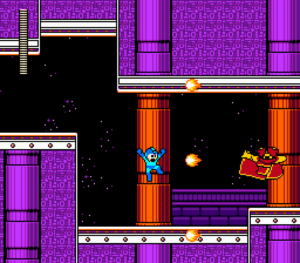
Polish:
At last we come to general polish and this game sure does have a lot of it. One thing in particular which I appreciate is the fact that Mega Man: Super Fighting Robot always sets Mega Man’s lives back up to the default of three at the start of a new stage if they have fallen below this amount – there’s no more need to plummet Mega Man to his death just because you finished the previous stage with one life remaining. There are quite a few options available too, including standard ones like window size adjustment and volume sliders for music and sound effects, but also an option to make the charging sound effect fade over time and another for adjusting the game’s system resource usage priority; options to toggle on an input display and a timer for individual stages or for total time are even present, both of which are handy for speedrunners. There is a generous amount of save slots, eight in total, and five different difficulties are available, which can be swapped around at any point other than while in a stage. The difficulties themselves seem to only affect enemy health and damage, so don’t expect to see new abilities or different stage layouts on higher settings, though the lower settings do add in flying platforms across several of the pits.
Once you finish the game, you can choose to fight any boss on any difficulty and receive a ranking, though it is unclear as to if damage taken factors into your final rank or if it is purely a matter of aiming for the fastest time possible; meeting certain requirements while playing the game even unlocks several secret bosses. A remarkably useful help submenu is also available from the pause screen and it includes a description of every weapon and item you currently have as well as more detailed statistics for the speed, strength, and energy consumption of each weapon on top of how many copies of that weapon can be on-screen at a time. In addition to all of this, bonus options exist which include changing the sound of Mega Man’s buster, reducing gravity, displaying hitboxes, and several other neat or silly features. My only complaint here is that the CD’s you need to collect to unlock these bonus options only appear in stages after you’ve completed the game at least one time, but this is at least somewhat balanced out by these bonuses becoming unlocked across all current and future playthroughs once they are collected.
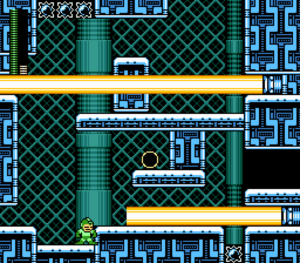
Conclusion:
If you’re primarily interested in seeing a variety of interesting stage mechanics used in clever ways you may be disappointed with Mega Man: Super Fighting Robot and would likely be better off playing Mega Man Unlimited or Mahou Warrior. However, this game more than makes up for its generally lackluster stage gimmicks with a massive number of unique enemies, exceptional enemy placement, bosses which are both aesthetically creative and consistently fun to fight, and plenty of secrets.